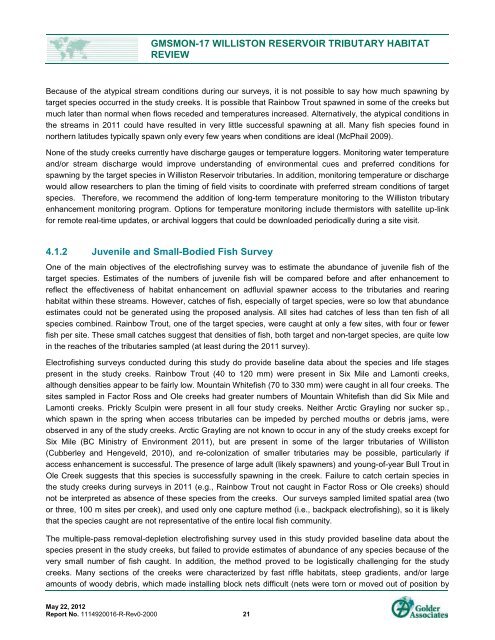GMSMON-17 WILLISTON RESERVOIR TRIBUTARY - BC Hydro
GMSMON-17 WILLISTON RESERVOIR TRIBUTARY - BC Hydro
GMSMON-17 WILLISTON RESERVOIR TRIBUTARY - BC Hydro
You also want an ePaper? Increase the reach of your titles
YUMPU automatically turns print PDFs into web optimized ePapers that Google loves.
May 22, 2012<br />
Report No. 1114920016-R-Rev0-2000 21<br />
<strong>GMSMON</strong>-<strong>17</strong> <strong>WILLISTON</strong> <strong>RESERVOIR</strong> <strong>TRIBUTARY</strong> HABITAT<br />
REVIEW<br />
Because of the atypical stream conditions during our surveys, it is not possible to say how much spawning by<br />
target species occurred in the study creeks. It is possible that Rainbow Trout spawned in some of the creeks but<br />
much later than normal when flows receded and temperatures increased. Alternatively, the atypical conditions in<br />
the streams in 2011 could have resulted in very little successful spawning at all. Many fish species found in<br />
northern latitudes typically spawn only every few years when conditions are ideal (McPhail 2009).<br />
None of the study creeks currently have discharge gauges or temperature loggers. Monitoring water temperature<br />
and/or stream discharge would improve understanding of environmental cues and preferred conditions for<br />
spawning by the target species in Williston Reservoir tributaries. In addition, monitoring temperature or discharge<br />
would allow researchers to plan the timing of field visits to coordinate with preferred stream conditions of target<br />
species. Therefore, we recommend the addition of long-term temperature monitoring to the Williston tributary<br />
enhancement monitoring program. Options for temperature monitoring include thermistors with satellite up-link<br />
for remote real-time updates, or archival loggers that could be downloaded periodically during a site visit.<br />
4.1.2 Juvenile and Small-Bodied Fish Survey<br />
One of the main objectives of the electrofishing survey was to estimate the abundance of juvenile fish of the<br />
target species. Estimates of the numbers of juvenile fish will be compared before and after enhancement to<br />
reflect the effectiveness of habitat enhancement on adfluvial spawner access to the tributaries and rearing<br />
habitat within these streams. However, catches of fish, especially of target species, were so low that abundance<br />
estimates could not be generated using the proposed analysis. All sites had catches of less than ten fish of all<br />
species combined. Rainbow Trout, one of the target species, were caught at only a few sites, with four or fewer<br />
fish per site. These small catches suggest that densities of fish, both target and non-target species, are quite low<br />
in the reaches of the tributaries sampled (at least during the 2011 survey).<br />
Electrofishing surveys conducted during this study do provide baseline data about the species and life stages<br />
present in the study creeks. Rainbow Trout (40 to 120 mm) were present in Six Mile and Lamonti creeks,<br />
although densities appear to be fairly low. Mountain Whitefish (70 to 330 mm) were caught in all four creeks. The<br />
sites sampled in Factor Ross and Ole creeks had greater numbers of Mountain Whitefish than did Six Mile and<br />
Lamonti creeks. Prickly Sculpin were present in all four study creeks. Neither Arctic Grayling nor sucker sp.,<br />
which spawn in the spring when access tributaries can be impeded by perched mouths or debris jams, were<br />
observed in any of the study creeks. Arctic Grayling are not known to occur in any of the study creeks except for<br />
Six Mile (<strong>BC</strong> Ministry of Environment 2011), but are present in some of the larger tributaries of Williston<br />
(Cubberley and Hengeveld, 2010), and re-colonization of smaller tributaries may be possible, particularly if<br />
access enhancement is successful. The presence of large adult (likely spawners) and young-of-year Bull Trout in<br />
Ole Creek suggests that this species is successfully spawning in the creek. Failure to catch certain species in<br />
the study creeks during surveys in 2011 (e.g., Rainbow Trout not caught in Factor Ross or Ole creeks) should<br />
not be interpreted as absence of these species from the creeks. Our surveys sampled limited spatial area (two<br />
or three, 100 m sites per creek), and used only one capture method (i.e., backpack electrofishing), so it is likely<br />
that the species caught are not representative of the entire local fish community.<br />
The multiple-pass removal-depletion electrofishing survey used in this study provided baseline data about the<br />
species present in the study creeks, but failed to provide estimates of abundance of any species because of the<br />
very small number of fish caught. In addition, the method proved to be logistically challenging for the study<br />
creeks. Many sections of the creeks were characterized by fast riffle habitats, steep gradients, and/or large<br />
amounts of woody debris, which made installing block nets difficult (nets were torn or moved out of position by
















